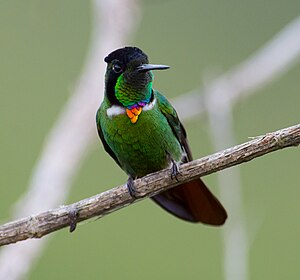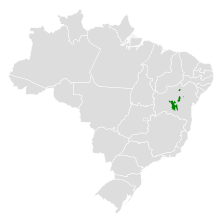Gold mask hummingbird
| Gold mask hummingbird | ||||||||||
|---|---|---|---|---|---|---|---|---|---|---|

Gold masked hummingbird ( Augastes lumachella ) |
||||||||||
| Systematics | ||||||||||
|
||||||||||
| Scientific name | ||||||||||
| Augastes lumachella | ||||||||||
| ( Lesson, RP , 1839) |
The hooded visorbearer or hood Hummingbird ( Augastes lumachella ) is a species of bird in the family of hummingbirds (Trochilidae). This endemic species occurs only in the South American country of Brazil . The IUCN classifies the population as “ Near Threatened ”.
features

(lithograph by Henry Constantine Richter (1821–1902) after a drawing by John Gould (1804–1881))
The male golden masked hummingbird reaches a body length of about 10.1 cm, while the female is only about 8.9 cm tall. Both sexes have a weight of approx. 4 grams. The straight black beak is up to 19.2 mm long. The male has a glossy golden-green forehead and throat, the throat having a golden-red extension that is wine-red at the base. The cap-like top of the head is velvet black with a bluish tone. It is velvety black on the sides of the neck. The top and bottom as well as the wing covers shine bronze gold green. The lower plumage is white between the throat and the chest. The wings are black-purple and the under-tail-coverts are red-gold. The tail sparkles dark copper red. The upper tail-coverts are blue-green. The feet are black. The female resembles the male in appearance but is slightly paler in color. The skull is blackish-blue-green and the sides of the neck are brown. Gray shades mix in the underside and the under tail. The cock springs are gold, red, with the outer control springs have a gray color.
distribution and habitat
The hummingbird lives in the central high mountains of the Serra do Sincorá in the Brazilian state of Bahia . Here you can always find it at heights between 950 and 1600 meters, in rocky regions that are overgrown with cacti and low shrubs.
behavior
The hummingbird flies at heights of around 50 to 100 cm. He also builds the nest only 60 to 100 cm above the ground. It is built very open, cup-shaped in forked branches. He uses flying seeds from bromeliads and daisy family , in addition to the cotton wool-like cactus felt and some pieces of leaf that are covered with spider threads and moss. The nest looks yellowish-gray to gray.
Etymology and history of research
René Primevère Lesson described the hummingbird under the name Ornismya lumachella . He gave the state of Bahia in Brazil as the place of discovery . The type specimen comes from the collection of Charles Parzudaki (1806–1889). It was John Gould who classified it in the new genus Augastes in his delivery of 1 of his hummingbird tablets in 1849 . This name is of Greek origin and is derived from »augastēs, augē αυγαστης, αυγη « for »light transmitter, radiant , sunlight«. "Lumachella" refers to an ammolite-colored marble made of petrified shells and snails that is found in Italy and Austria. The Italian »lumaca« means »shell«, which is derived from the Latin »limaceus, limax« for »slug«.
Rediscovery
In 1957 Augusto Ruschi and the French ornithologist Jacques Berlioz visited the Natural History Museum in London , where there were 14 bellows of Augastes lumachella . They found that the species had not been collected in half a century. While Berlioz concluded that the species was extinct, Ruschi wasn't convinced. In the American Museum of Natural History he found a hide with the location Morro do Chapeú in Brazil. There were three cities with this name in Brazil. In 1961 Ruschi decided to visit the one at the foot of a mountain of the same name. After eight unsuccessful days, he wanted to give up, then he succeeded in rediscovering the species in a gorge almost 200 meters deep at the Chachoeira do Ferro Doido waterfall . He extended his stay by two days and collected 24 males and females of the bird that was thought to be extinct.
literature
- Rolf Grantsau : The rediscovery of the Brazilian hummingbirds Augastes scutatus and Augastes lumachellus . In: Journal of Ornithology . tape 109 , no. 4 , 1968, p. 434-437 , doi : 10.1007 / BF01671577 .
- Rolf Grantsau: The hummingbirds of Brazil . Expressão e Cultura, Rio de Janeiro 1988, ISBN 978-85-208-0101-7 .
- Walter Scheithauer: Hummingbirds. Flying gems . BLV Buchverlag, Munich 1982, ISBN 978-3-405-10684-3 .
- James A. Jobling: Helm Dictionary of Scientific Bird Names . Christopher Helm, London 2010, ISBN 978-1-4081-2501-4 .
- René Primevère Lesson : Espèces nouvelles d'oiseaux mouches . In: Revue Zoologique par La Société Cuvierienne . tape 1 , 1838, p. 314-315 ( online [accessed July 16, 2014]).
- John Gould: A monograph of the Trochilidæ, or family of humming-birds . tape 4 , Shipment 1. Taylor and Francis, London 1849 ( online [accessed July 16, 2014]).
Web links
- Augastes lumachella inthe IUCN Red List of Threatened Species 2014.1. Listed by: BirdLife International, 2012. Retrieved July 16, 2014.
- BirdLife International: Species Factsheet - Hooded Visorbearer ( Augastes lumachella ) . Retrieved July 16, 2014.
- Videos, photos and sound recordings of Hooded Visorbearer (Augastes lumachella) in the Internet Bird Collection
- Gold Masked Hummingbird ( Augastes lumachella ) at Avibase; Retrieved July 16, 2014.
- Augastes lumachella in the Integrated Taxonomic Information System (ITIS). Retrieved July 16, 2014.
- xeno-canto: Sound recordings - Gold masked hummingbird ( Augastes lumachella )


